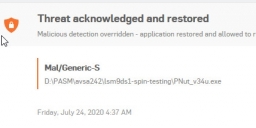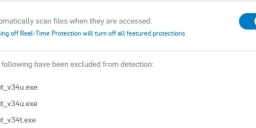Windows 10 Pro version 2004 and PNut
 kg1
Posts: 164
kg1
Posts: 164
in Propeller 2
I upgraded 2 of my PCs from 1909 to 2004 on 10 June 2020 both completed automatically via Windows Update. The third PC had the standard message that MS was waiting until they considered it was safe to upgrade. On the 7 August 2020 I decided waiting 2 months was long enough so I followed https://bleepingcomputer.com/news/microsoft/windows-10-2004-update-not-offered-heres-how-to-get-it-now/
and followed the option of using windows10upgrade9252.exe which proved to be 100% ok for me. For the first time my Bluetooth keyboard and Bluetooth mouse were handle by the upgrade process without manual configuration. I believe the delay for some PCs is due to the involvement of the PC manufacturer. These three upgrades have been 100% successful for me.
Have a look at https://docs.microsoft.com/en-us/windows/whats-new/whats-new-windows-10-version-2004 and especial note anything about Windows Defender System Guard. Also of interest may be Windows Subsystem for Linux 2 https://docs.microsoft.com/en-us/windows/wsl/compare-versions.
In May 2020 I made this comment: forums.parallax.com/discussion/comment/1496319#Comment_1496319
and today I still have no problem with Windows Defender.
I am using: https://sophos.com/en-us.aspx Sophos has control of Windows Defender.
@AJL I would be interested to see snap-shots of your exclusion steps. I am using Windows 10 Pro version 2004 which may be different from 1903. Windows Security has made changes in 2004. Also I elected to have Sophos control Windows Security Virus Protection. I entered the PNut file name into Sophos website and they provided the exclusion in Windows Security: Everything may be turned off including their AI machine learning (see attached).
I assume that Microsoft know that Sophos use AI machine learning and therefore also use AI machine learning themselves but MS do not provide access to turn it off.
I believe there are three parts to the problem plaguing PNut:
(1) Many PC Users try anything and everything to fix the problem (a behavioral problem: how does AI assess this?). Does a Virus Protection System quarantine files or does it "delete" them? Some Windows Defender problems may be resolved by completing a new install of Windows OS i.e. clean out the history.
(2) AI detection of a possible new virus: there may be a lack of human verification to determine if it is a real threat: many forum users should create an exclusion of PNut in Windows Security and Parallax should raise an issue with Microsoft based on anti-competitive behavior: Parallax is a seller of compilers: Microsoft is a seller of compilers.
(3) If a executable is not signed: Is this part of an Virus Protection System's criteria? I believe this may only generate Windows System warning messages.
I hope many forum users create a Windows Security exclusion for PNut and take snap-shots of every step in their exclusion process and provide their windows system version etc and post them to this thread.
Regards,
Kevin
and followed the option of using windows10upgrade9252.exe which proved to be 100% ok for me. For the first time my Bluetooth keyboard and Bluetooth mouse were handle by the upgrade process without manual configuration. I believe the delay for some PCs is due to the involvement of the PC manufacturer. These three upgrades have been 100% successful for me.
Have a look at https://docs.microsoft.com/en-us/windows/whats-new/whats-new-windows-10-version-2004 and especial note anything about Windows Defender System Guard. Also of interest may be Windows Subsystem for Linux 2 https://docs.microsoft.com/en-us/windows/wsl/compare-versions.
In May 2020 I made this comment: forums.parallax.com/discussion/comment/1496319#Comment_1496319
and today I still have no problem with Windows Defender.
I am using: https://sophos.com/en-us.aspx Sophos has control of Windows Defender.
@AJL I would be interested to see snap-shots of your exclusion steps. I am using Windows 10 Pro version 2004 which may be different from 1903. Windows Security has made changes in 2004. Also I elected to have Sophos control Windows Security Virus Protection. I entered the PNut file name into Sophos website and they provided the exclusion in Windows Security: Everything may be turned off including their AI machine learning (see attached).
I assume that Microsoft know that Sophos use AI machine learning and therefore also use AI machine learning themselves but MS do not provide access to turn it off.
I believe there are three parts to the problem plaguing PNut:
(1) Many PC Users try anything and everything to fix the problem (a behavioral problem: how does AI assess this?). Does a Virus Protection System quarantine files or does it "delete" them? Some Windows Defender problems may be resolved by completing a new install of Windows OS i.e. clean out the history.
(2) AI detection of a possible new virus: there may be a lack of human verification to determine if it is a real threat: many forum users should create an exclusion of PNut in Windows Security and Parallax should raise an issue with Microsoft based on anti-competitive behavior: Parallax is a seller of compilers: Microsoft is a seller of compilers.
(3) If a executable is not signed: Is this part of an Virus Protection System's criteria? I believe this may only generate Windows System warning messages.
I hope many forum users create a Windows Security exclusion for PNut and take snap-shots of every step in their exclusion process and provide their windows system version etc and post them to this thread.
Regards,
Kevin





Comments
Fingers crossed.
Also indicated on the sticky thread:
Downloading a fresh copy of PNut_v34 from the google drive flags a threat, but downloading PNut_v34vb from Github does not.
2. CI can sign the code using the non-EV (cheap, no-hassle) code signing certificate Parallax surely should have, during the build process - the private key password is passed as an encrypted (secret) variable to the CI, and doesn't need to be revealed to 3rd parties.
I am at loss why this is not done... surely you're not building this stuff by hand before distributing it? If you (whoever "you" is) are doing it by hand: stop, switch to CI, and enjoy gobs of free time to be used for more productive things. Win-win.
IOW, the fact that PNut is not signed as a step in an automated release build process is incomprehensible to me. Not doing it is actually harder than doing it right.
Here is the current process:
1) I hit F9 in Delphi to compile PNut.exe.
2) I rename the file to reflect the current version.
3) I put the file into the zip file.
4) I load the zip file to my Google Drive, set sharing, and copy the link.
5) I paste the link into the top post of the PNut thread.
Which type and version of assembly are you using for your compiler? Microsoft Macro Assembler 8.0 (MASM) Package (x86)?
Will your compiler for the P2 ever be open source?
Regards,
Kevin
Yes, I'm using Borland Delphi 6 (c) 2001.
I also use Borland Turbo Assembler for 32-bit x86 code.
I don't know if I will open-source it all. If I were to rewrite the compiler in some common language, I would certainly open-source it.
At least you should take a look at freepascal. But I would really like if you would be able to get it running in Spin2. Sure you will need file access to SD but that is already solved, same with Hyper-ram access if needed for compilation of larger files.
Make it multi-pass like @mpark did with Sphinx for the P1. Sure a lot of people will argue to use C because of cross platform compile-ability , but I can feel some reluctance at your side to use C, Me, myself and I never liked that language very much but sadly was forced to use it on some of my contracts.
Another way would be to stay completely in Assembler but use FASM and the FreshLib Library to make it Windows and Linux compatible. Might not solve the Virus issue.
But I really, really have the opinion that the current Operating Systems ALL force you to updates, changes - and supporting my software over decades is a challenge I fight with and I am loosing the fight.
Even Z-OS on the MF starts doing this even if the IBM Processors have a quite smart OP-Code Mapping so on can run 370 code from 1960 on any newer System today without recompilation.
And now they start breaking things even there.
So tl;dr;
Borland Delphi 6 from 2001 will not cut it any longer. The fastest way might be to pay @"Roy Eltham" to repeat what he did with OpenSpin and translate your ASM to C, he at least knows your programming style.
Anyways,
Mike
Enjoying,
Mike
I really don't have the time to do the porting as quickly as it's needed. I can help, and OpenSpin is already there as a port of the P1 compiler.
Not sure why you wouldn't release the x86 source code?
I have not studied the detailed output but it does not reject code made by your kind of tools. See attached.